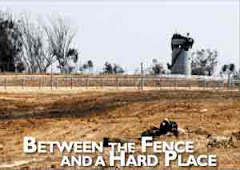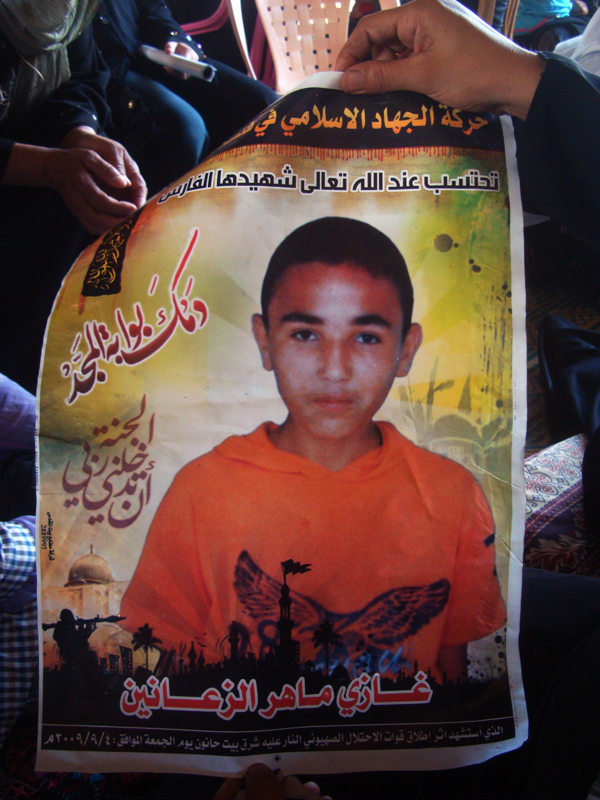by: Pam Rasmussen, t r u t h o u t | Op-Ed
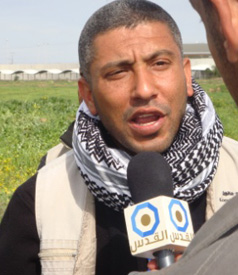
Saber Az-Za'aneen, coordinator of the Local Initiative Committee in Beit Hanoun, speaks at a protest in Gaza's "buffer zone." (Photos: Pam Rasmussen)
When I wrote last, I was still in Cairo, beginning to lose hope. However, shortly after, a friend at the UN Relief & Works Agency (UNRWA) was miraculously able to get me into Gaza through Israel's Erez Crossing. In a shockingly quick two days, I was in! Among my first activities was this protest....
The Israelis call it the "buffer zone." Gazan NGOs often call it the "hot zone." But to the Palestinians who live near this wide swath of land alongside the border between the Gaza Strip and Israel, it is fertile land where their children played and they made a decent living by raising wheat and olives. That is, until Israel declared the land off limits to Palestinians.
The so-called "buffer zone" is a military no-go area that extends along the entire northern and eastern Gazan border with Israel,
as well as its southern border with Egypt (known as the Philadelphi Corridor). The creation of a 50-meter-wide buffer zone was agreed to as part of the security arrangements included in an interim Palestinian-Israeli agreement signed in 1995. Following the start of the second Intifada in September 2000, the area of the buffer zone was increased to 150 meters wide. In May 2009, the Israeli military scattered thousands of leaflets warning residents to maintain a distance of at least 300 meters from the border or risk being fired upon. In reality, however, the buffer zone can extend up to two kilometers (1.2 miles) at its widest point in North Gaza.
As a result, the area once known as the most bountiful in the Gaza Strip in terms of the families it supported or fed has become a no-man's land - a killing field where Palestinians have been targeted for venturing past the invisible, amorphous demarcation line - or sometimes, for simply being too close and rousing the Israelis' suspicions. Since the end of the Israeli military offensive in January 2009, the UN estimates that five civilians have been killed and 20 injured in incidents involving Israeli gun and tank fire in areas near the buffer zone. Three of the fatalities and at least four of the injured were children.
For Saber Az-Za'aneen, a former field worker for a human rights agency and now the full time coordinator of the Local Initiative Committee in Beit Hanoun (in the northern Gaza Strip), it was the deaths of children that drove him to finally fight back.
Saber Az-Za'aneen
He ticks off the incidents that he says finally made him realize that Palestinians had to overcome their fear and fight back. There were four children walking near the agricultural college (the only one in Gaza and now in ruins) ... another three children tending their sheep ... another three playing in the shadow of their home ... a mother and her four children eating breakfast at their kitchen table. (In the latter case, an Israeli drone killed a suspected resistance fighter, then bombed a nearby house for good measure). Last September, a 14-year-old boy was killed while walking with his father.
The Israeli military has said it needs the buffer zone to make it more difficult for resistance fighters to fire rockets and mortars into the Jewish state and set off explosives near the border wall. "What determines our actions are the threats. It's not right to place the blame on Israel; the [Palestinian] farmers should blame the militants and the terror organizations," an Army spokeswoman said.
Once a plush scene of rolling olive, citrus and pomegranate groves, much of the border region (accounting for 30-40 percent of Gaza's arable farmland and a significant number of water wells) is now just a barren landscape. According to a recent Save the Children UK study, up to 70 percent of households living near the buffer zone have been either temporarily or permanently displaced at least once since 2000, primarily as a result of house demolitions and fear for the families' personal safety. In addition, 50 percent of the families have lost their source of income or livelihood during the same period. As a result, 42 percent of those families have changed their residence.
"To protect 45 families in Sderot (the Israeli town closest to the Israel's southern border with Gaza), it has destroyed every aspect of life for 45,000 people here," said Az-Za'aneen. "They have driven us from the land we have farmed for decades, and made our children frightened of something as simple as playing in their back yard."
Only 9 percent of respondents in the Save the Children UK survey said they felt secure in their neighborhood, compared with 55 percent of respondents among the general population in Gaza.
In September 2008, Az-Za'aneen began organizing weekly marches of local farmers and their families into the no-go zone - protests that continued, despite the Israeli Army's use of live ammunition in retaliation, until the 22-day invasion in December 2008-January 2009. Az-Za'aneen launched them once again a month ago. "Our goal is to reinforce the farmers' steadfastness, to give them the courage to keep planting and harvesting their olives despite the Israelis' threats," he said.
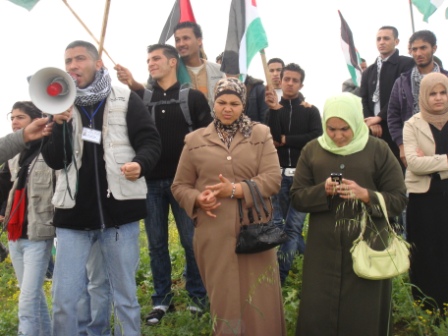
Farmers march in the "buffer zone."
Az-Za'aneen's model was the weekly marches in protest of the Apartheid Wall being built in the West Bank, which have attracted extensive publicity due to the participation of international activists. However, due to the almost complete prohibition of travel in and out of the Gaza Strip by Israel and Egypt, international participation in Beit Hanoun is limited to the few volunteers (primarily with the International Solidarity Movement) who manage to enter Gaza with aid convoys. During the most recent protest, the group of about 50 protesters managed to plant a Palestinian flag about 50 meters from the barrier wall near the Erez Crossing into Israel (the closest residents have managed to get in ten years) before shots from the guard tower rang out, forcing them back.
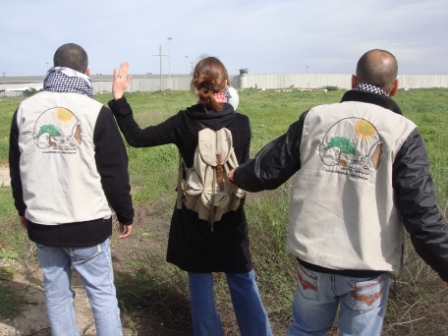
Eva Bartlett asks the Israeli guards not to shoot, explaining that the marchers are unarmed and peaceful.
"It is important for internationals to show both Palestinians and Israel that despite the fact that our governments indirectly support the ongoing blockade, the Palestinians are not alone, " said Eva Bartlett, a Canadian human rights advocate and freelance writer who arrived in Gaza with the third Free Gaza boat in November 2008. "The Israelis continually make and break their own rules, and they must be exposed."
And so it goes ... every week, trying to push a little farther. The Israelis may shoot, but the Palestinian's connection to the land and their history, is stronger.
http://www.truthout.org/life-gazan-buffer-zone57419?print

